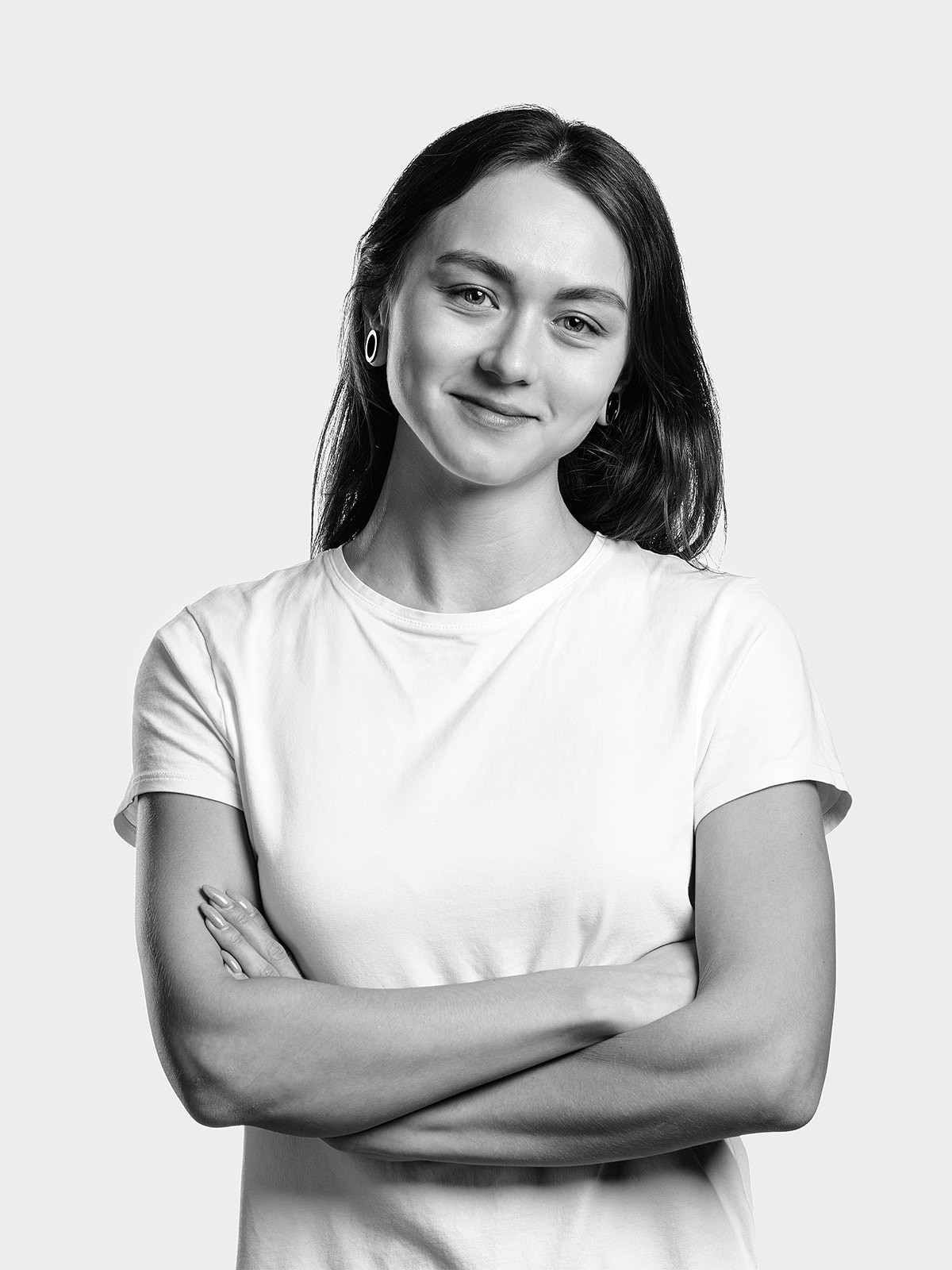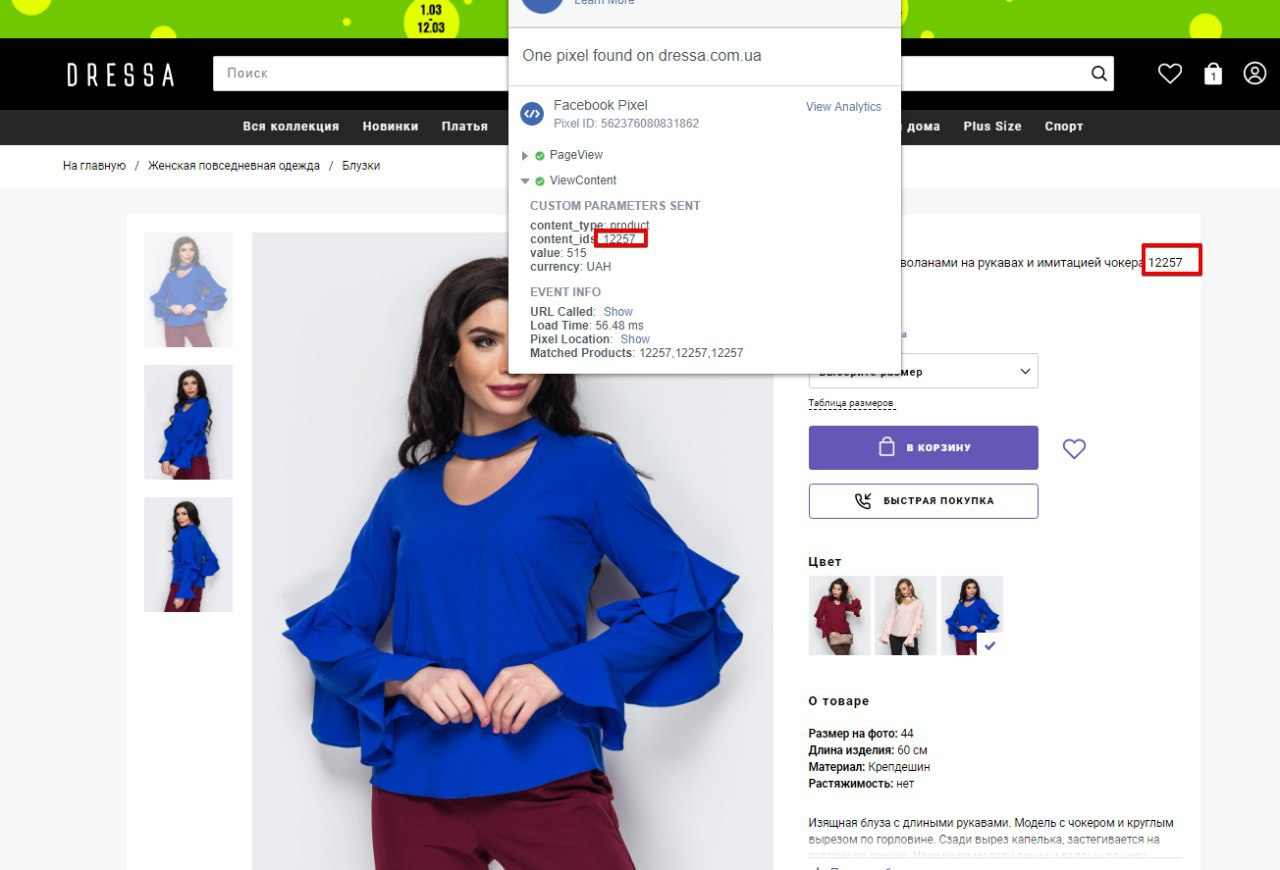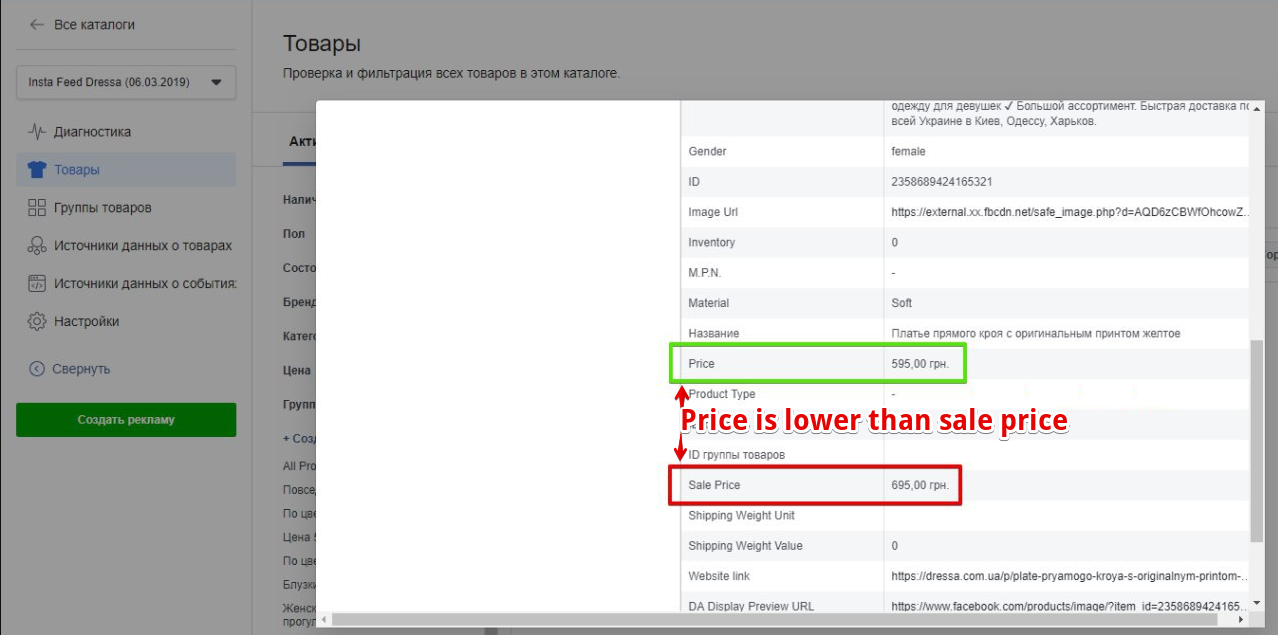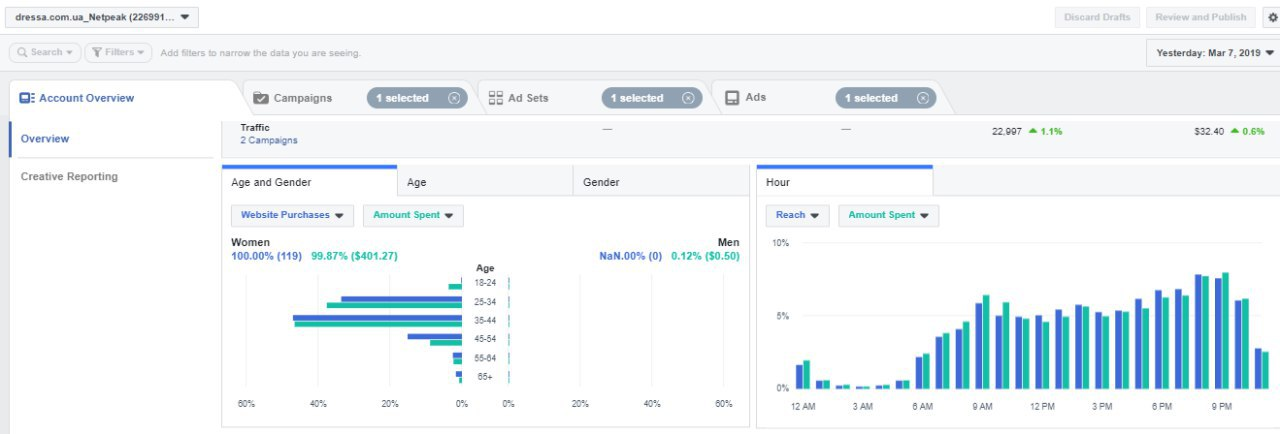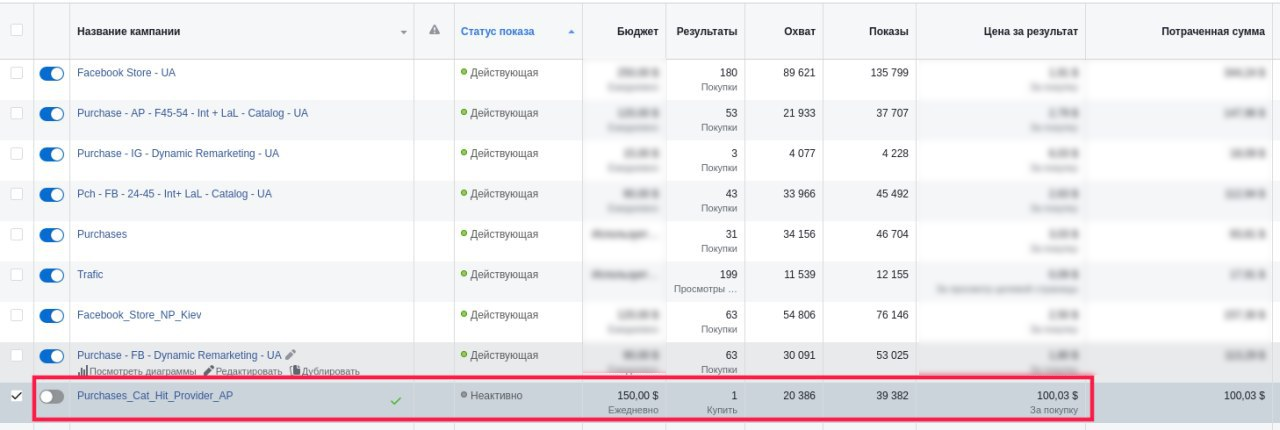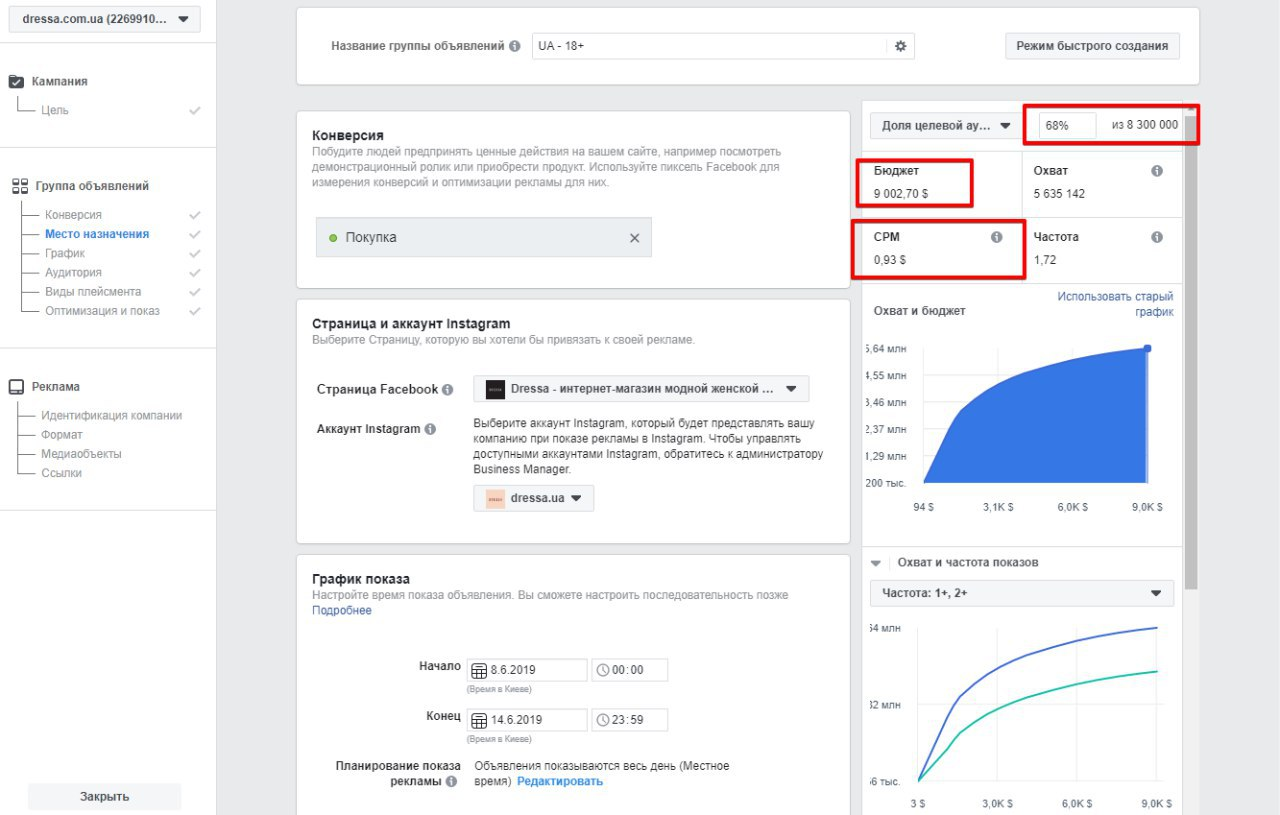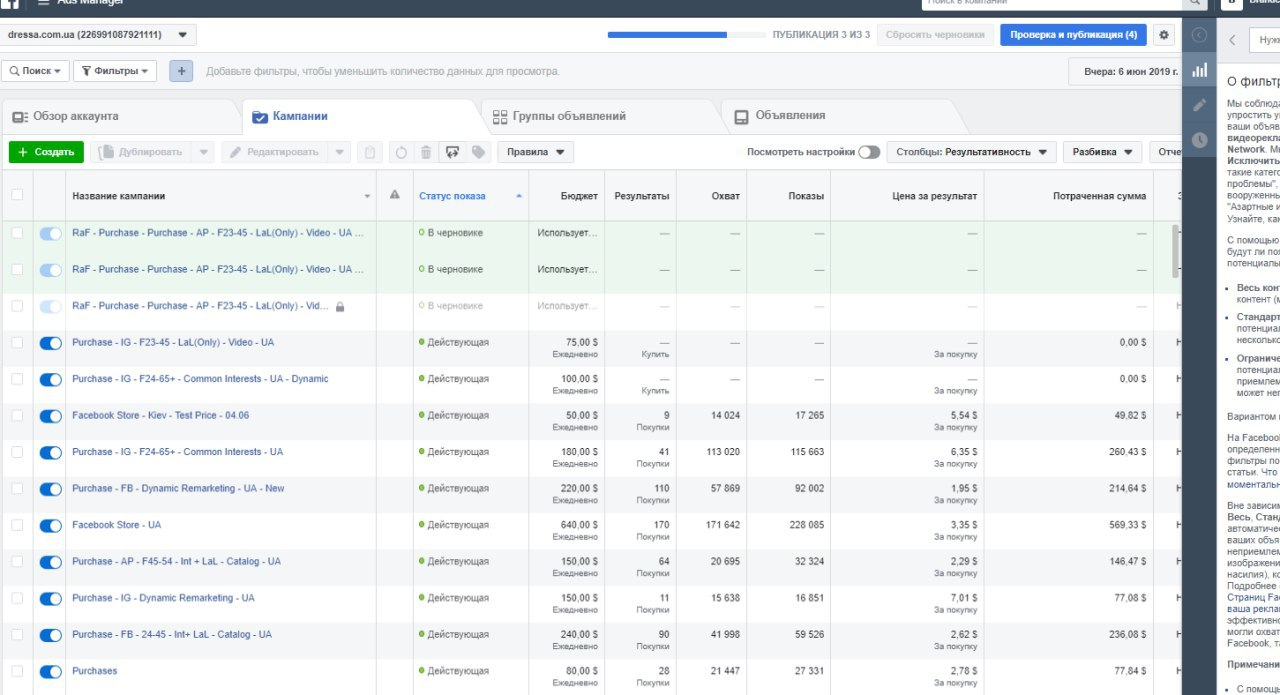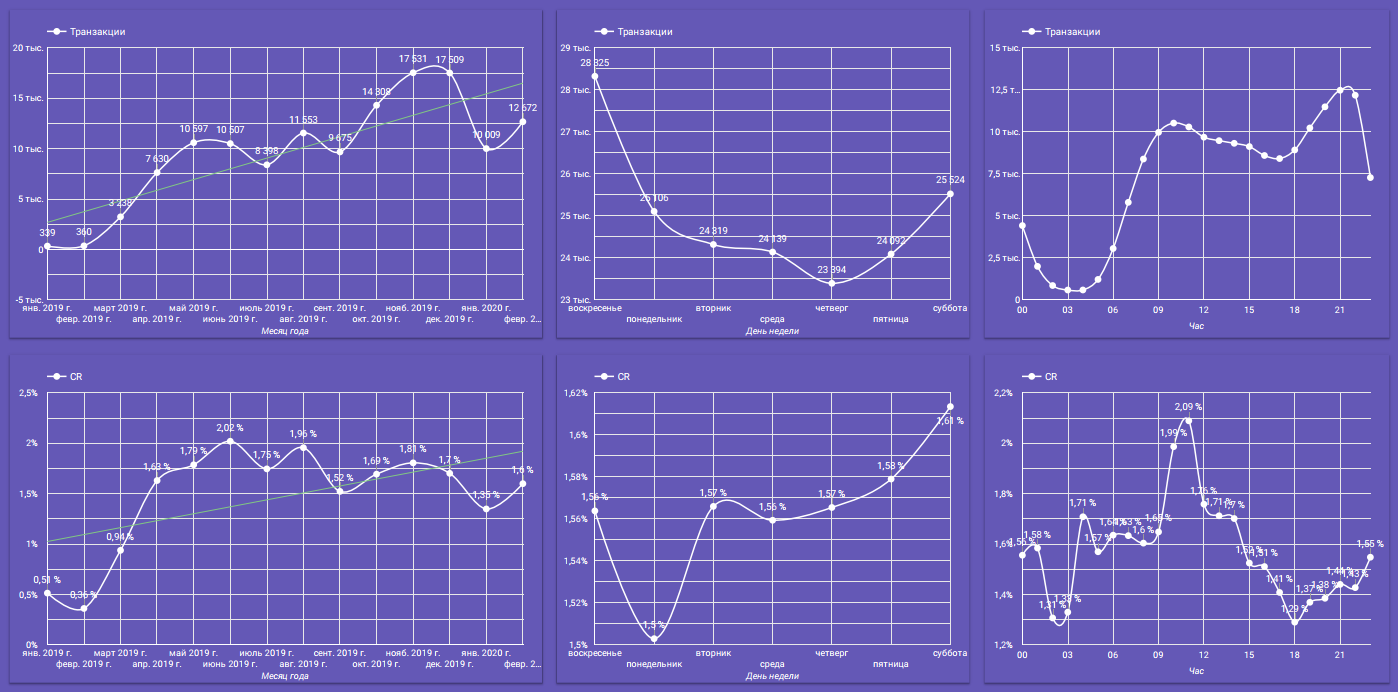Ukraine

Region of activity
Period of work
2019-2020
The project before the start of work
- 100+ new products each two weeks
- 12+ years in the niche
- Dressa.ua is the client's second project for retail sales of women's clothes
- We had a limited time for launching a project in marketing
- The client had minimal Facebook ads experience, the previous contractor hadn't meet the expectations
Project team
Project description
Tasks and KPI
- Low margin pushed business to reach payback on volumes > 100 sales daily, with CPA < $ 10;
Analysis Phase
We started to work in February 2019
The task was to optimize Facebook ads and scale campaigns from 10-12 daily sales to at least 100 with CPA not bigger than $10
We conducted an audit of the ad account to find all possible errors and the current state of advertising from Facebook and Instagram placements.
As a result, we found several serious shortcomings of the previous contractor:
- Mismatched product IDs in the pixel and feed. Dynamic campaigns could not be optimized, so users received irrelevant products for display that they were not interested in.
- For more than half a year, there were no impressions from the Instagram placement, although it was specified in the settings. This happened because the resolution of pictures in the catalog was 480x600, with a minimum of 600x600. This error reduced impressions to zero for this placement on the whole. And the previous contractor ignored it.
- We found an issue with feed prices. The sale price was higher than the usual price. It impacted the campaign's performance.
- The previous contractor's campaigns worked improperly. Nothing was improving or changing in them. Facebook found the optimal strategy for performance by itself.
- When we'd corrected the errors, we were able to significantly improve the results and test.
Launching Phase
The first thing we did was start fixing the issues. We've created a technical task for the Facebook pixel and a feed for a developer.
Thus, we started testing placements. Our campaigns were optimized better due to matching product IDs. We were given carte blanche on the tests, as we had only 2 months to deliver results.
Having studied our audience, we defined their needs. We had a hypothesis that our target audience was women aged 25-44.
The next step was to segment the audience by age and interests. All audiences of women 25-44 were gathered so that they did not exclude each other. All segments of the audience of women were gathered so that they did not overlap.
We did not have segments of the audience overlapping by more than 10%. This way, it was possible to find effective segments.
Some of these segments fell into the price of $10, some did not. We launched campaigns for about $15 per segment. We received 2 sales daily from such a segment at best. We did not reach the expected result this way.
Additionally, we conducted testing with a split by text and headings. We identified the most effective ones for the audience.
We noticed that LLA and the audience for relevant interests in clothing worked best.
We settled on the best segments of the audience that brought us conversions and began to go deep into the segmentation of the catalog by type of clothing: dresses, blouses, skirts.
Before that, we were relevantly showing products based on interests. We differentiated between the office and casual clothes and evening dresses.
From the attempt to attempt, we began to notice that segments with 15 (not 5) ads at the same time worked poorly. This was eating away at our efficiency.
Facebook just couldn't find what works for people, and couldn't optimize.
Having noticed these patterns, we began to show 3-5 ads maximum of all the clothes at once. Now the ads differed from each other by the design rather than by the range of clothes.
We used all the available functionality: carousels with overlays and prices, carousel slideshow, and instant experience. In our case, it didn't make sense to segment that narrowly. When only dresses are shown in the catalog, they worked worse.
A month later, the client added the one-click purchase functionality to the website and we offered to run a 1 + 1 = 3 promotion.
First Result
After implementing all these things, and in the case of conducted promotion, we dropped from CPA $10 to CPA=$2.5-$4.
Thus, in just three days of the promotion, we grew from 20 purchases per day to 150 ones. It was a really fantastic improvement for us.
The client was also happy.
After the promotion, we decided to cut only 40% of the budget. As a result, the price per conversion remained quite the same, with the results of 100-120 sales daily.While we were testing further, the client was already thinking about the next promotion.
Target Audience
After a while, we decided to test the older and younger segments.
There was a test:
- 16-23
- 45-54
- 55- 65+
We set a small budget and noticed that 44+ gave an excellent result. So we began to raise by this age almost daily. And as practice showed, this segment could compete on equal terms with 25-44 segment.
And the segment aged 16-23 failed. Girls at this age often do not have their own income, and in general, our products did not catch their attention.
Also:
- We came to the conclusion that the ads needed to be simplified
- In the visual, we showed general feeds and put a plate on the company's promotions and offers
- In the ads by text, the USP was approved, it had the maximum conversion rate
We reduced segments with interests to about 3-4 segments.
Next, we tested Facebook and Instagram placements separately.
We came to the conclusion that campaigns perform better when placements were combined. Facebook could optimize and give the maximum transactions at the lowest cost. As a result, in the context of our campaigns, Facebook brought 90% of all results, and Instagram about 10%.
The CBO strategy also performed well. CBO stands for campaign budget optimization, that is, we no longer gave the budget to the group of companies.
It was enough to allocate a larger budget for a campaign with all groups, and Facebook itself found better results. We allocated the groups that did not bring us necessary results with a mandatory budget, and the best ones were generally taken out in separate campaigns.
- There were many hypotheses, but not all were successful. Moreover, about 90% of them failed.
Growing Phase
Growth of the indicators
On the second promotion, we reached 350 conversions daily.
The growth was rapid and the results were really pleasing. The customer call center couldn't even handle the load.
By the next, third promotion, we have grown to 500 conversions daily. At this point, we've already optimized everything as much as possible and the result was such a structure of campaigns outside the promotion.
We continued to beat our results and in august we achieved 1320 daily conversions
On average, we had 500-700 purchases daily. The budget from which we started was $30-50 per day, and grew, during the super-promotions, up to $2200. On days without promotions — $1500.
Team Work
The client, for his part, tried to optimize delivery, the working processes of the call center, and the website as much as possible.
For example:
- The dress could be seen not only in the photo but also in the video — to evaluate how it fits, its style and color
- In addition to the size chart, it was possible to specify your dimensions on the website. The site provided a calculation of how this dress would fit the customer
- There were convenient forms of registration and bonuses
- Loyalty system, free delivery, quick orders, a huge selection of clothes for every taste, convenient filters and categories, and much more
Used Tools
- Google Analytics
- OWOX
- Google spreadsheets
- Prospective Campaigns
- Dynamic Remarketing
- Remarketing Campaigns
- Conversion Campaigns
- RaF campaigns
Our Conclusion
- Dressa gained experience that helped them make excellent profits
- Dressa learned how to work and make money with Facebook
- Facebook was the engine that let this project grow and advance. Compare to Google ads, Facebook brought in almost x2.5 times more revenue.
Result
